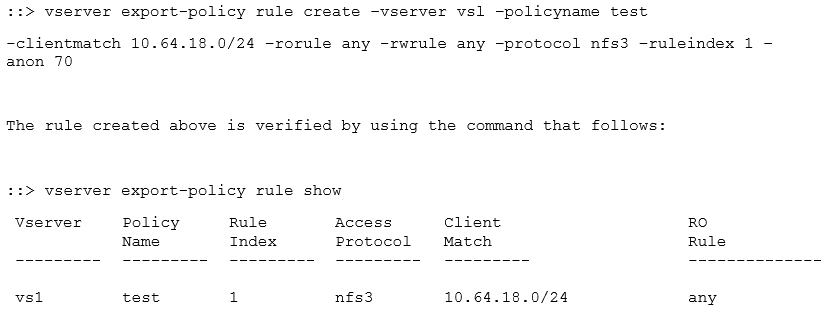Click the Exhibit button.

An export policy rule for a volume is set by using the command shown in the exhibit.
If clients with IP addresses 10.64.19.0 and 10.64.18.20 accessed the export, what is the outcome?
Click the Exhibit button.

An export policy rule for a volume is set by using the command shown in the exhibit.
If clients with IP addresses 10.64.19.0 and 10.64.18.20 accessed the export, what is the outcome?
In the provided command, a rule is created with a client match for the IP range 10.64.18.0/24 using the NFSv3 protocol. The client match pattern 10.64.18.0/24 represents the IP range from 10.64.18.0 to 10.64.18.255. Therefore, a client with the IP address 10.64.18.20 falls within this range and will be given access. However, the IP address 10.64.19.0 falls outside this range and will not be granted access. Consequently, only the client 10.64.18.20 is given access, while the client 10.64.19.0 is not.
Should be C -> https://library.netapp.com/ecmdocs/ECMP1196891/html/GUID-23762F2F-C02A-482E-A5B2-7E165DB24973.html
Answer is C
ans is C
Looks like C is the correct answer. Here is the Link to the ONTAP 9 Documentation https://docs.netapp.com/ontap-9/index.jsp?topic=%2Fcom.netapp.doc.dot-cm-sag%2FGUID-65C34C6C-29A0-4DB7-A2EE-019BA8EB8A83.html
sure it is D?
Taken from the link that anonymous515 posted, proves it's C Example The export policy contains an export rule with the following parameters: -protocol nfs3 -clientmatch 10.1.16.0/255.255.255.0 -rorule any -rwrule any The client access request is sent using the NFSv3 protocol and the client has the IP address 10.1.17.37. Even though the client access protocol matches, the IP address of the client is in a different subnet from the one specified in the export rule. Therefore, client matching fails and this rule does not apply to this client.
The correct answer is:- C. Client 10.64.19.0 is not given access but 10.64.18.20 is given access.